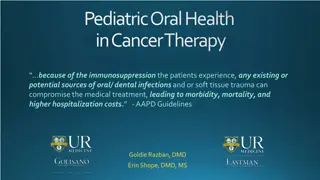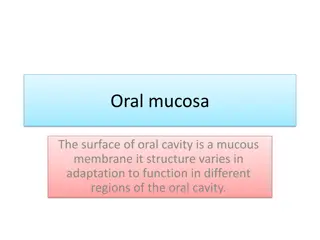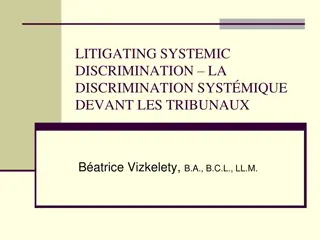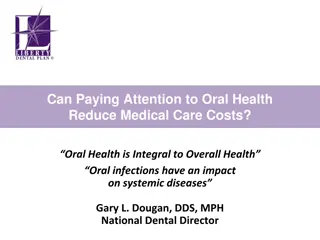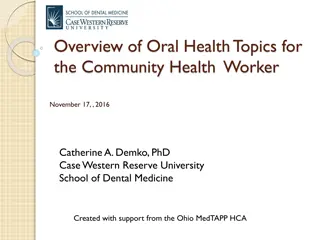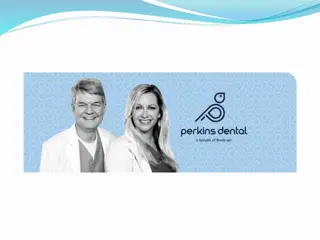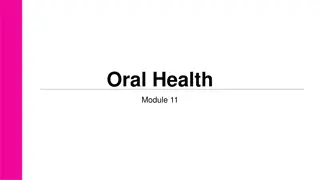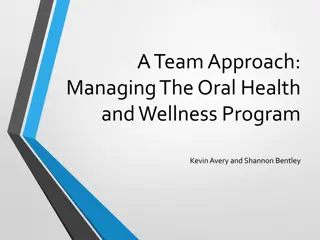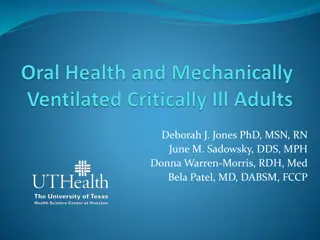Understanding the Connection Between Oral Health and Systemic Diseases
The relationship between oral health and systemic diseases is significant, with manifestations within the oral cavity providing clues to underlying systemic issues. Disease processes involve aspects like etiology, pathogenesis, morphologic changes, and clinical significance. Organisms and toxins spread through various routes in the body, impacting health in unexpected ways. Focal infections can lead to severe consequences beyond the oral cavity, affecting organs and tissues systemically. Recognizing the implications of oral health on overall well-being is crucial in preventing potential complications such as heart disease.
Download Presentation

Please find below an Image/Link to download the presentation.
The content on the website is provided AS IS for your information and personal use only. It may not be sold, licensed, or shared on other websites without obtaining consent from the author. Download presentation by click this link. If you encounter any issues during the download, it is possible that the publisher has removed the file from their server.
E N D
Presentation Transcript
Manifestasi klinis intraoral penyakit sistemik Yayun Siti Rochmah
The four aspects of a disease process that form the core of pathology are its : 1. 2. 3. Cause (etiology) The mechanisms of its development (pathogenesis) Structural alterations induced in the cells and organ of the body (morphologic change) The functional consequences of the morphologic changes (clinical significance) 4.
Distribution of organisms and their toxins throughout the body is by various routes: blood circulation through out the body lymphatic distribution locally and then to blood stream retrograde axonal transport - transport along nerve fibres and back to the brain.
There are two major mechanisms of focal infection: a) an actual metastasis of organisms from a focus b) the spread of toxins or toxic products from a remote focus to other tissues by the blood stream.
Once the infection passes the abscess area about the tooth: a) they may multiply in the blood setting up an acute or chronic septicaemia. b) they may be carried live to a suitable nidus where they infect the surrounding tissue. c) they may produce a slow but progressive atrophy with replacement fibrosis in various organs of the body.
The bacteria at the focus may undergo autolysis or dissolution. Some of the products of this dissolution, diffusing into the blood or lymph , may sensitise in an allergic sense, various tissues of the body." "A later diffusion of these products on reaching the sensitised tissue may call forth an allergic reaction."
A study by the University of Buffalo, the same bacteria causing those gum problems end up either directly infecting your heart arteries or somehow causing other blockages. A study at the University of Minnesota in 1998 showed that by injecting rabbits with tooth plaque bacteria, caused blood clots which lead to heart attacks. Patients between the ages 30-40 who showed evidence of bone loss around teeth were 50% more likely to have a coronary heart problem.
Fatal heart disease was twice as common in those with periodontal infection. Haraszthy et al. 1999. Identification of periodontal pathogens in atheromatous plaques. J. Periodontol 2000 71(10): 1554-60.al Wu T. 2000. Periodontal disease and risk of cerebrovascular disease: the first national health and nutrition examination survey and its follow-up study. American Journal of Epidemiology 151: 273-282. Cancer Periodontal disease is a risk factor for prostate cancer and probably breast cancer as well as many other cancers.
Systemic Risks from the Oral Bacteria In getting your teeth cleaned, bacteria will enter the blood stream. This is called bacteremia. These bacteria can settle out and grow in blood vessels, heart valves, the heart, and many other tissues in the body. Infections in the mouth can lead to systemic problems.
C C- -Reactive Protein Reactive Protein Medical researchers now think that periodontal disease is related to increased levels of C-Reactive Protein. Toxins, which are generated as waste by periodontal bacteria get into the blood and trigger the liver to make more C-Reactive Protein. Studies have shown that those with moderate or advanced perio disease have much higher levels of C-Reactive Protein than those that do not have periodontal disease. Chronic Inflammation anywhere in the body compromises the rest of the body.
Protein C- reaktif Protein C-reactif (C-reactive protein, CRP) dibuat oleh hati dan dikeluarkan ke dalam aliran darah. CRP beredar dalam darah selama 6-10 jam setelah proses inflamasi akut dan destruksi jaringan. Kadarnya memuncak dalam 48-72 jam. CRP merupakan uji non-spesifik.
CRP merupakan salah satu dari beberapa protein yang sering disebut sebagai protein fase akut dan digunakan untuk memantau perubahan-perubahan dalam fase inflamasi akut yang dihubungkan dengan banyak penyakit infeksi dan penyakit autoimun. Beberapa keadaan dimana CRP dapat dijumpai meningkat adalah radang sendi (rheumatoid arthritis), demam rematik, kanker payudara, radang usus, penyakit radang panggung (pelvic inflammatory disease, PID), penyakit Hodgkin, SLE, infeksi bakterial. CRP juga meningkat pada kehamilan trimester akhir, pemakaian alat kontrasepsi intrauterus dan pengaruh obat kontrasepsi oral.
The conditions for infection and growth of bacteria: Acid condition leads to anaerobic metabolism BURNS SUGAR 4 ATP Anaeroic environment Continual sugar exposure
Mucosal defenses against invading bacteria in the oral cavity The oral mucosa has three types of antimicrobial defenses: physical barrier of the epithelial layer nonspecific (innate) immunity derived from salivary constituents, neutrophils, and epithelial antimicrobial peptides adaptive immunity associated with mucosa- associated lymphatic tissues (MALT).
Molecular analyses However, results of surveys with molecular tools indicate a level of diversity in the human subgingival microflora that cannot be recognized by conventional culture techniques. More than 700 bacterial species from the oral cavity have been identified. In most instances, the cultivatable microflora probably represent less than 1% of the total extant population, as estimated by microscopy or other means.
Correlation between plaque and gingivitis There is a positive correlation between the amount of bacterial plaque and the severity of gingivitis and amount of bone loss in cross-sectional studies of human populations.15 Antibody response to microbes Numerous studies indicate that subjects with destructive periodontal diseases show an elevated serum antibody response to specific subgingival organisms.16
Pathogenic potential of plaque bacteria Human bacterial plaque has demonstrated pathogenic potential when implanted into outside the mouth to sites such as subcutaneous destructive abscesses in humans or in experimental animals. A number of toxic products can be detected in dental plaque, including endotoxins, and cell wall mucopeptides. In addition, enzymes have been shown to be produced by whole plaque or individual microorganisms from plaque that can be demonstrated to hydrolyze a wide variety of tissue constituents. Finally, it must be pointed out that the bacterial masses that accumulate at or in the gingival sulcus possess an array of antigens and possibly polyclonal activators capable of triggering sequences of host-mediated events that have been postulated as mechanisms of tissue destruction.1


